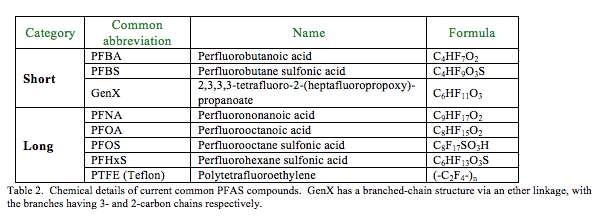As a child the writer was told a joke about a liquid which dissolved everything. The question was what container could you keep it in? We now have a modern counterpart, a compound (or indeed, thousands of related compounds to date) that do not degrade, and the question arising is how can they be prevented from accumulating in the environment? The molecules in question are carbon chain compounds in which all mid-chain carbon atoms are bonded to two fluorine atoms. The result is compounds that are extraordinarily chemically stable and resist physical or biological degradation. The energy content of carbon single bonds1 with fluorine and other common atoms present in organic molecules (Table 1) demonstrates why polyfluorinated alkyl substances (PFAS) are resistant to degradation and hence potentially hazardous or toxic. In addition, fluorine atoms are large compared to oxygen and hydrogen and impose steric hindrance on potential substitution.

Note especially the difference in the energies of carbon/fluorine and carbon/oxygen bonds. These data demonstrate why polyfluoalkys in the environment cannot degrade by oxidisation except under special conditions, why they are effective flame retardants for use in bushfires and fires at military bases, and why as polytetrafluoroethylene (Teflon®) they can render cooking equipment “non-stick”. The number of PFAS that could be synthesised is almost without limit, and there are currently over 9000 types including seven commonly available discrete compounds (“legacy” PFAS2), as shown in table 2, grouped as either “short chain” (4-6 carbon atoms) or “long chain” (6-9 carbons). Teflon is a polymer.

An obvious question is whether these compounds are toxic, given their chemical stability, as in general they are rapidly absorbed and widely distributed after administration, and not metabolised in vivo, in keeping with their chemical stability. However, the physical properties of PFAS may affect metabolic processes indirectly. For example, would their presence in the lining of the biliary tract or renal tubules be harmless? One suspects not. The toxicology data are difficult to interpret because (a) effects differ in humans and animal models; (b) the spectrum of pathological effects varies amongst PFAS in Table 2; (c) concentration-effect (dose-response) curves cannot be compiled easily; (d) prospective controlled studies are not possible; and (e) typical human exposure is often to more than one PFAS but the potential for combined toxicology is not known. Most toxicology data is for PFOA and PFOS.

The associations shown in Table 3 do not amount to proven cause and effect, and some remain qualitative or even vague. For this reason, chemical or drug authorities and health equivalents tend to to play down possible PFAS environmental toxicology. For example, the Australian Government PFAS Taskforce website rather inconsistently states: “The Australian Government’s Expert Health Panel for PFAS found that although the scientific evidence in humans is limited, reviews and scientific research to date have provided fairly consistent reports of an association with several health effects. The health effects reported in these associations are generally small and within normal ranges for the whole population. There is also limited to no evidence of human disease or other clinically significant harm resulting from PFAS exposure at this time.”3 The Victorian Environmental Protection Agency states:4 “Most of us are exposed to low levels of PFAS. This is mostly from eating food or drinking water with PFAS in it. This is unlikely to be harmful to our health. Recent studies show people’s exposure to PFAS in the general environment is reducing”. These quotations agree that PFAS are common environmental contaminants and that proof of substantial health effects is lacking, but may be over-reassuring.
Nevertheless, scientific studies in animals have shown clear links between PFAS exposure and health effects. The most reliable epidemiological evidence comes from the USA. The literature is vast and it is helpful to refer to authoritative summary papers.5,6 Human toxicology cannot be inferred directly from animal data and has to include objective criteria for assigning confidence that any association indicates cause and effect. Using these criteria, the US National Center for Biotechnology Information has published7 “sufficient” evidence of an association between PFAS exposure and decreased antibody response (in adults and children), dyslipidemia (in adults and children), decreased infant and fetal growth, and increased risk of kidney cancer (in adults). In contrast, the often quoted relationship in laboratory animals between PFAS and increased liver enzymes was assigned the lower category of “limited or suggestive” evidence. We note that even the strongest category above the report does not include a claim that the link with PFAS is causal. Thus, unlikely as it seems, even the strongest associations in this field may turn out to be non-causal, and this may justify the temperate language used in the Australian websites.
On the other hand the ubiquity of environmental PFAS is undeniable. Friends of the Earth Australia provide 2,424 geographical site entries or other references in the pages accompanying the Australian PFAS Map,8 with comment that PFAS are “ubiquitous” across Australia and accompanying emotive text (“PFAS chemicals have been linked to a number of diseases, yet the Australian Government stubbornly refuses to end the use of PFAS chemicals in Australia, even after they have been banned overseas”). FOEA also call PFAS “the new asbestos”, though at present, in spite of evidence of increased mortality according to tertiles of PFAS exposure,9 this appears to be an exaggeration. We note that only a few countries or US states have banned PFAS.
The efects of PFAS are not limited to health. In Australia, compensatory payments have been made by the government in settlement of individiual and class action claims by citizens living close to high use areas such as defence bases.10 The settlement was for reductions in property values in these areas, not for health effects. In the US, the 3M Company has agreed to provide funding of US$10.3bn over 13 years to “provide funding for public water suppliers nationwide that have detected PFAS in drinking water, as well as for eligible PWS that may detect PFAS at any level in the future”11 Again, this enormous expenditure is not for clinical purposes. But the amount provided in relation to the likely threat of disease is eye-watering, and the reason for the lack of concordance between the cash being paid and the human consequences is uncertain.
How might the threats of PFAS be moderated? Banning PFAS is unlikely to be effective because of their economic importance. Finding ways of destroying the offending chemical species is one option. Though the bond energies suggest that such an approach with PFAS is impossible, “ball milling” using boron nitride has been shown to be successful in destroying PFAS in sediments (but not in water).12 Nevertheless, PFAS destruction appears not to be an impossibility. So hope of a solution remains.
In summary, PFAS is a chemical class with valuable properties across any industrialised economy. At the same time, once they escape into the environment they are impossible to eradicate and toxicological effects if any are likely to become progressively more marked. Currently these effects appear modest, but current health effects on biological systems generally and humans in particular are likely to increase and may become significant. Clearly a system of control is required. Who will provide it?
References
- Song K, Le D. Bond Energies. https://chem.libretexts.org/Bookshelves/Physical_and_Theoretical_Chemistry_Textbook_Maps/Supplemental_Modules_(Physical_and_Theoretical_Chemistry)/Chemical_Bonding/Fundamentals_of_Chemical_Bonding/Bond_Energies
- Fenton SE, Ducatman A, Boobis A, DeWitt JC, Lau C, Ng C et al. Per- and Polyfluoroalkyl Substance Toxicity and Human Health Review: Current State of Knowledge and Strategies for Informing Future Research. Environ Toxicol Chem. 2021; 40(3): 606–630. https://doi: 10.1002/etc.4890.
- Australian Government PFAS Taskforce. https://www.pfas.gov.au/about-pfas/affects
- Environmental Prootection Agency, Victoria. About PFAS: Find out about what PFAS are and EPA’s advice about their presence in the environment. https://www.epa.vic.gov.au/for-community/environmental-information/pfas
- Di Nisio A, Rocca MS, De Toni L, Sabovic I, Guidolin D et al. Endocrine disruption of vitamin D activity by perfluoro-octanoic acid (PFOA). Sci Rep 10, 16789 (2020). https://doi.org/10.1038/s41598-020-74026-8.
- Radke EG, Wright MJ, Christensen K, Lin CJ, Goldstone AE et al. Epidemiology Evidence for Health Effects of 150 per- and Polyfluoroalkyl Substances: A Systematic Evidence Map. Environ Health Perspect. 2022 Sep; 130(9): 096003. doi: https://10.1289/EHP11185.
- National Academies of Sciences, Engineering, and Medicine; Health and Medicine Division; Division on Earth and Life Studies; Board on Population Health and Public Health Practice; Board on Environmental Studies and Toxicology; Committee on the Guidance on PFAS Testing and Health Outcomes. Guidance on PFAS Exposure, Testing, and Clinical Follow-Up. Washington (DC): National Academies Press (US); 2022 Jul 28. 3, Potential Health Effects of PFAS. Available from: https://www.ncbi.nlm.nih.gov/books/NBK584690/
- Australian PFAS Chemicals Map. htpps://pfas.australianmap.net
- Wen X, Wang M, Xu X, and Li T. Exposure to Per- and Polyfluoroalkyl Substances and Mortality in U.S. Adults: A Population-Based Cohort Study. Env Hlth Perspectives 130(6); 2022. https://doi.org/10.1289/EHP10393
- The Guardian. Australian government reaches $132.7m class action settlement with landowners over PFAS contamination. May 2023. https://www.theguardian.com/environment/2023/may/15/australian-government-reaches-1327m-class-action-settlement-with-landowners-over-pfas-contamination
- 3M Company News Center. https://news.3m.com/2023-06-22-3M-Resolves-Claims-by-Public-Water-Suppliers,-Supports-Drinking-Water-Solutions-for-Vast-Majority-of-Americans.
- Yang N, Yang S, Ma Q, Beltran C, Guan Y et al. Solvent-Free Nonthermal Destruction of PFAS Chemicals and PFAS in Sediment by piezoelectric ball milling. Environ Sci Technol Lett. 2023 Feb 14; 10(2): 198–203. doi: 10.1021/acs.estlett.2c00902
J A Millar
31 July 2023
